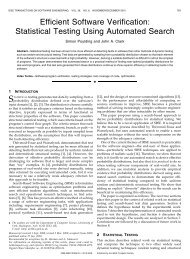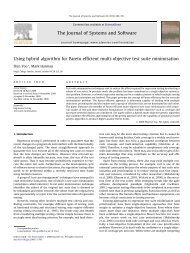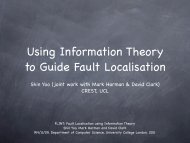Introduction to SAT (constraint) solving - Crest
Introduction to SAT (constraint) solving - Crest
Introduction to SAT (constraint) solving - Crest
You also want an ePaper? Increase the reach of your titles
YUMPU automatically turns print PDFs into web optimized ePapers that Google loves.
<strong>Introduction</strong> <strong>to</strong> <strong>SAT</strong> (<strong>constraint</strong>) <strong>solving</strong><br />
Justyna Petke
<strong>SAT</strong>, SMT and CSP solvers are used for <strong>solving</strong> problems<br />
involving <strong>constraint</strong>s.<br />
The term “<strong>constraint</strong> solver”, however, usually refers <strong>to</strong> a<br />
CSP solver.
The 8-queens problem
The Boolean satisfiability problem (<strong>SAT</strong>)<br />
is the problem of deciding whether there is a variable<br />
assignment that satisfies a given propositional formula.
<strong>SAT</strong> example<br />
x 1 ∨ x 2 ∨ ¬x 4<br />
¬x 2 ∨ ¬x 3<br />
◮ x i : a Boolean variable<br />
◮ x i , ¬x i : a literal<br />
◮ ¬x 2 ∨ ¬x 3 : a clause
The 8-queens problem
The 8-queens problem : <strong>SAT</strong> model<br />
p cnf 64 744<br />
1 2 3 4 5 6 7 8 0<br />
-1 -2 0<br />
-1 -3 0<br />
-1 -4 0<br />
-1 -5 0<br />
-1 -6 0<br />
-1 -7 0<br />
-1 -8 0<br />
-2 -3 0<br />
-2 -4 0<br />
-2 -5 0<br />
-2 -6 0<br />
-2 -7 0<br />
-2 -8 0<br />
-3 -4 0<br />
-3 -5 0<br />
-3 -6 ..
The Satisfiability Modulo Theories (SMT)<br />
is the problem of deciding whether there is a variable<br />
assignment that satisfies a given formula in first order logic with<br />
respect <strong>to</strong> a background theory.
Example background theories for SMT<br />
◮ Equality with Uninterpreted Functions<br />
(e.g. f(x) = y ∧ f(x) ≠ y is UN<strong>SAT</strong>)<br />
◮ Non-linear arithmetic (e.g. x 2 + yz ≤ 10)<br />
: variables can be reals<br />
◮ Arrays (e.g. write(a, x, 3) = b, read(a, x) = b)<br />
◮ Bit vec<strong>to</strong>rs (e.g. x[0 : 1] ≠ y[0 : 1])
The 8-queens problem : SMT model
The Constraint Satisfaction Problem (CSP)<br />
is the problem of deciding whether there is a variable<br />
assignment that satisfies a given set of <strong>constraint</strong>s.
The 8-queens problem : CSP model<br />
ESSENCE ′ 1.0<br />
given n : 8<br />
letting queens_n be domain int(0..n − 1)<br />
find queens : matrix indexed by [ queens_n ] of queens_n<br />
such that<br />
alldifferent(queens),<br />
forall i, j : queens_n .<br />
(i > j) => ((queens[i] - i ! = queens[j] - j)<br />
/\ (queens[i] + i ! = queens[j] + j))
<strong>SAT</strong>, SMT or CSP<br />
◮ <strong>SAT</strong>:<br />
+ extremely efficient<br />
- problem with expressivity<br />
◮ SMT:<br />
+ better expressivity, incorporates domain-specific<br />
reasoning<br />
- some loss of efficiency<br />
◮ CSP:<br />
+ very expressive, uses domain-specific reasoning<br />
- some loss of efficiency
<strong>SAT</strong>, SMT or CSP<br />
◮ <strong>SAT</strong>:<br />
+ extremely efficient<br />
- problem with expressivity<br />
◮ SMT:<br />
+ better expressivity, incorporates domain-specific<br />
reasoning<br />
- some loss of efficiency<br />
◮ CSP:<br />
+ very expressive, uses domain-specific reasoning<br />
- some loss of efficiency<br />
highly problem-dependent though..
A short introduction <strong>to</strong> <strong>SAT</strong> <strong>solving</strong>
<strong>SAT</strong> solver classification<br />
◮ complete <strong>SAT</strong> solvers<br />
: based on the Davis-Putnam-Logemann-Loveland (DPLL)<br />
algorithm<br />
◮ incomplete <strong>SAT</strong> solvers<br />
: based on local search<br />
◮ hybrid <strong>SAT</strong> solvers
<strong>SAT</strong> solver classification<br />
Most widely used <strong>SAT</strong> solvers:<br />
◮ Conflict-Driven Clause Learning (CDCL) <strong>SAT</strong> solvers
Why use <strong>SAT</strong> solvers
<strong>SAT</strong> solvers are extremely efficient<br />
Year Variables Clauses<br />
60s - 70s tens hundreds
<strong>SAT</strong> solvers are extremely efficient<br />
Year Variables Clauses<br />
60s - 70s tens hundreds<br />
80s - early 90s hundreds thousands
<strong>SAT</strong> solvers are extremely efficient<br />
Year Variables Clauses<br />
60s - 70s tens hundreds<br />
80s - early 90s hundreds thousands<br />
late 90s thousands hundreds of thousands
<strong>SAT</strong> solvers are extremely efficient<br />
Year Variables Clauses<br />
60s - 70s tens hundreds<br />
80s - early 90s hundreds thousands<br />
late 90s thousands hundreds of thousands<br />
00s - now hundreds of thousands millions<br />
and more
<strong>SAT</strong> Applications<br />
◮ Bounded Model Checking<br />
◮ Planning<br />
◮ Software Verification<br />
◮ Au<strong>to</strong>matic Test Pattern Generation<br />
◮ Combinational Equivalence Checking<br />
◮ Combina<strong>to</strong>rial Interaction Testing<br />
◮ and many others..
How do CDCL <strong>SAT</strong> solvers work
CDCL <strong>SAT</strong> solver
Unit propagation<br />
x 0 ∨ x 2 ∨ x 3<br />
¬x 2 ∨ ¬x 3<br />
decision: x 3 = 0<br />
decision level: 1
Unit propagation<br />
x 0 ∨ x 2 ∨ x 3<br />
¬x 2 ∨ ¬x 3<br />
decision: x 3 = 0<br />
decision level: 1
Unit propagation<br />
x 0 ∨ x 2<br />
¬x 2 ∨ ¬x 3 : satisfied<br />
decision: x 3 = 0<br />
decision level: 1
Unit propagation<br />
x 0 ∨ x 2<br />
¬x 2 ∨ ¬x 3 : satisfied<br />
decision: x 3 = 0 (d.l. 1), x 2 = 0<br />
decision level: 2
Unit propagation<br />
x 0 ∨ x 2<br />
¬x 2 ∨ ¬x 3 : satisfied<br />
decision: x 3 = 0 (d.l. 1), x 2 = 0<br />
decision level: 2
Unit propagation<br />
x 0<br />
¬x 2 ∨ ¬x 3 : satisfied<br />
decision: x 3 = 0 (d.l. 1), x 2 = 0<br />
decision level: 2
Unit propagation<br />
x 0<br />
¬x 2 ∨ ¬x 3 : satisfied<br />
decision: x 3 = 0 (d.l. 1), x 2 = 0 (d.l. 2), x 0 = 1 (cl. 1)<br />
decision level: 2
Unit propagation<br />
x 0 : satisfied<br />
¬x 2 ∨ ¬x 3 : satisfied<br />
decision: x 3 = 0 (d.l. 1), x 2 = 0 (d.l. 2), x 0 = 1 (cl. 1)<br />
decision level: 2
<strong>SAT</strong> solver (60s)<br />
F = BCP(F) : unit propagation (Boolean <strong>constraint</strong> propagation)<br />
if F = True : return satisfiable<br />
if empty clause ∈ F : return unsatisfiable<br />
pick remaining variable x and literal l ∈ {x, ¬x}<br />
if DPLL(F ∧ {l}) returns satisfiable : return satisfiable<br />
return DPLL(F ∧ {¬l})
Conflict Analysis (late 90s)<br />
Mini<strong>SAT</strong> demo<br />
http : //minisat.se/Papers.html
Conflict Analysis - implication graph
Conflict Analysis - conflict clause<br />
Candidate conflict clauses:<br />
¬(x 3 = 0 ∧ x 2 = 0 ∧ x 0 = 1) ↔ x 3 ∨ x 2 ∨ ¬x 0<br />
or<br />
¬(x 3 = 0 ∧ x 2 = 0) ↔ x 3 ∨ x 2<br />
or<br />
¬(x 2 = 0 ∧ x 0 = 1) ↔ x 2 ∨ ¬x 0<br />
First Unit Implication Point (First UIP) scheme adds a conflict<br />
clause that contains only one variable that is assigned at the<br />
current decision level (a so-called asserting clause).
Conclusions
<strong>SAT</strong>, SMT and CSP solvers are used for <strong>solving</strong> problems<br />
involving <strong>constraint</strong>s.
CDCL <strong>SAT</strong> solver
<strong>SAT</strong> solvers are extremely efficient<br />
Year Variables Clauses<br />
60s - 70s few tens hundreds<br />
80s - early 90s few hundreds few thousands<br />
late 90s (tens of) thousands hundreds of thousands<br />
00s - now hundreds of thousands millions<br />
and more
<strong>SAT</strong> Applications<br />
◮ Bounded Model Checking<br />
◮ Planning<br />
◮ Software Verification<br />
◮ Au<strong>to</strong>matic Test Pattern Generation<br />
◮ Combinational Equivalence Checking<br />
◮ Combina<strong>to</strong>rial Interaction Testing<br />
◮ and many others..
References<br />
◮ Armin Biere, ed. Handbook of satisfiability. Vol. 185.<br />
IOS PressInc, 2009.<br />
◮ Clark W. Barrett, Rober<strong>to</strong> Sebastiani, Sanjit A. Seshia,<br />
Cesare Tinelli. Satisfiability Modulo Theories.<br />
Handbook of Satisfiability 2009: 825-885<br />
◮ Francesca Rossi, Peter Van Beek, and Toby Walsh, eds.<br />
Handbook of <strong>constraint</strong> programming. Vol. 2. Elsevier<br />
Science, 2006.<br />
◮ Mini<strong>SAT</strong> demo (“Practical <strong>SAT</strong> - a tu<strong>to</strong>rial on applied<br />
satisfiability <strong>solving</strong>”) http : //minisat.se/Papers.html
Example solvers<br />
◮ <strong>SAT</strong>: Mini<strong>SAT</strong>, Glucose, Cryp<strong>to</strong>Mini<strong>SAT</strong>, <strong>SAT</strong>4J<br />
◮ SMT: Z3, Yices, CVC4<br />
◮ CSP: Minion, Gecode, G12, ILOG, JaCoP<br />
◮ <strong>SAT</strong>- and SMT-based <strong>constraint</strong> solvers: Sugar, Fzn2smt<br />
◮ hybrid solvers: Chuffed<br />
◮ and many others (see <strong>SAT</strong>/SMT/CSP solver competitions<br />
and MiniZinc challenge)







